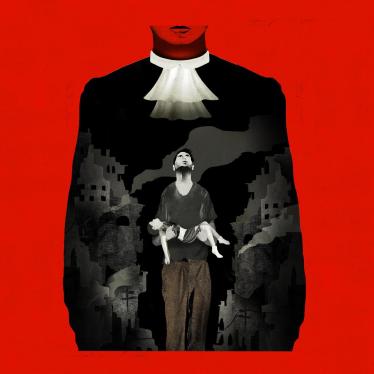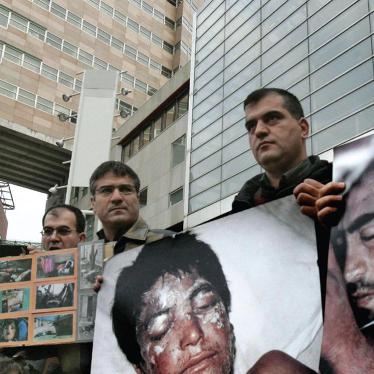Human Rights Watch categorically rejected Yugoslav government claims that the victims of the January 15 attack on Ra ak were either Kosovo Liberation Army soldiers killed in combat, or civilians caught in crossfire.
After a detailed investigation, the organization accused Serbian special police forces and the Yugoslav army of indiscriminately attacking civilians, torturing detainees, and committing summary executions. The evidence suggests that government forces had direct orders to kill village inhabitants over the age of fifteen.
The killing of forty-five ethnic Albanian civilians has provoked an apparent shift in western policy toward Kosovo, which the Contact Group is meeting in London today to discuss.
A report in the Washington Post yesterday provided excerpts from telephone conversations between Serbian Interior Ministry General Sreten Lukic and Yugoslav Deputy Prime Minister Nikola Sainovic, who clearly ordered government security forces to "go in heavy" in Ra ak. The two officials later discussed ways that the killings might be covered up to avoid international condemnation.
Human Rights Watch conducted separate interviews in Kosovo with fourteen witnesses to the attack, many of whom are hiding out of fear for their lives, as well as with foreign journalists and observers who visited Racak on January 16. Together, the testimonies suggest a well planned and executed attack by government forces on civilians in Racak, where the KLA had a sizable presence and had conducted some ambushes on police patrols.
As has happened on numerous occasions in the Kosovo conflict, once the KLA retreated, government forces moved in and committed atrocities against the residents of the village. While it is possible that some residents may have defended their homes in the morning, most were clearly not involved in any armed resistance. At least twenty-three people were summarily executed by the police while offering no resistance -- a clear violation of the laws of war, and a crime punishable by the International Criminal Tribunal for the former Yugoslavia (ICTY).
Villagers told consistent stories of how government forces rounded up, tortured, and then apparently executed the twenty-three ethnic Albanians on a hill outside of the village. Two witnesses interviewed by Human Rights Watch saw these men being beaten by the police and then taken off in the direction of the hill. Local villagers, foreign journalists, and diplomatic observers who saw the bodies the next day said that the victims had been shot from close range, most of them in the head; some of them appeared to have been shot while running away. Four men are known to have survived.
Eighteen other people were killed inside Ra ak, including a twelve-year-old boy and at least two female civilians, as well as nine soldiers of the KLA. At least one civilian, Nazmi Ymeri (76), was executed in his yard. Witnesses claim that Banush Kamberi, whose headless body was found in his yard, was last seen alive in the custody of the police. At least two people, Bajram Mehmeti and his daughter Hanumshahe (20), were killed by a grenade thrown by the police as they were running through the street.
Human Rights Watch confirmed that a group of approximately forty policeman, in blue uniforms and without masks, shot from a distance of twenty meters on unarmed civilians who were running through their yards. They killed Riza Beqa (44), Zejnel Beqa (22), and Halim Beqa (12), and wounded two women, Zyhra Beqa (42) and her daughter Fetije (18). It is believed that local policemen from the nearby Stimlje police station participated in this action.
The attack on civilians in Ra ak is one in a long series of war crimes committed by the Yugoslav Army and Serbian police during the Kosovo conflict. Since February 1998, government troops have systematically destroyed civilian property, attacked civilians, and committed summary executions, all of which are grave breaches of the laws of war. The Kosovo Liberation Army (KLA) has also committed some serious abuses, such as the taking of civilian hostages and summary executions. The KLA in the Shtimle and Suva Reka area was particularly known for a high number of kidnappings of ethnic Serbs.
Human Rights Watch called on the Yugoslav government to allow an unhindered investigation by international forensics experts and the war crimes tribunal to determine the precise nature of events. Government authorities, directly implicated in the crime, cannot be trusted to conduct an impartial investigation.
The organization also called on the international community to take resolute action against Yugoslav President Slobodan Milosevic and his government for brazenly violating international humanitarian law. International inaction in the face of past atrocities, the organization said, gave President Milosevic the rightful impression that he could continue his abusive campaign with impunity.
Finally, Human Rights Watch called on the Contact Group to insist that the Chief Prosecutor of the International War Crimes Tribunal for the Former Yugoslavia, Louise Arbour, be granted access to Ra ak and other sites of atrocities in Kosovo.






